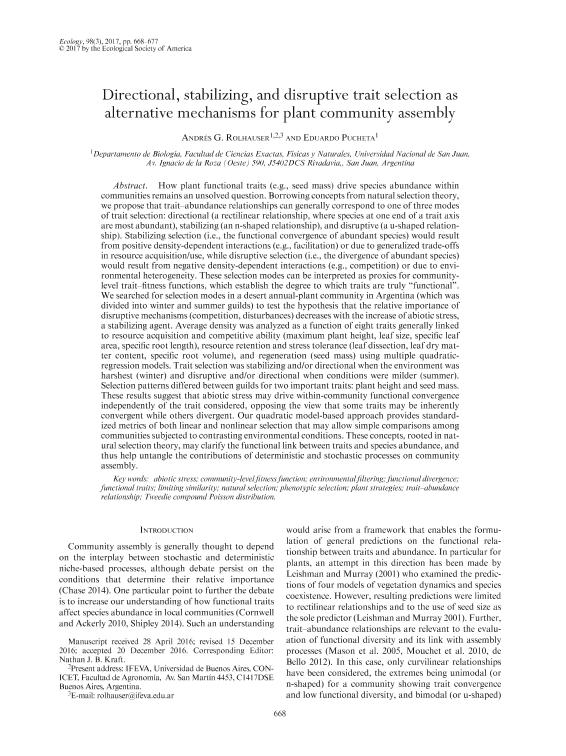Mostrar el registro sencillo del ítem
dc.contributor.author
Rolhauser, Andrés Guillermo

dc.contributor.author
Pucheta, Eduardo Raúl

dc.date.available
2018-07-02T20:37:30Z
dc.date.issued
2017-03-30
dc.identifier.citation
Rolhauser, Andrés Guillermo; Pucheta, Eduardo Raúl; Directional, stabilizing, and disruptive trait selection as alternative mechanisms for plant community assembly; Ecological Society of America; Ecology; 98; 3; 30-3-2017; 668-677
dc.identifier.issn
0012-9658
dc.identifier.uri
http://hdl.handle.net/11336/50952
dc.description.abstract
How plant functional traits (e.g., seed mass) drive species abundance within communities remains an unsolved question. Borrowing concepts from natural selection theory, we propose that trait-abundance relationships can generally correspond to one of three modes of trait selection: directional (a rectilinear relationship, where species at one end of a trait axis are most abundant), stabilizing (an n-shaped relationship), and disruptive (a u-shaped relationship). Stabilizing selection (i.e., the functional convergence of abundant species) would result from positive density-dependent interactions (e.g., facilitation) or due to generalized trade-offs in resource acquisition/use, while disruptive selection (i.e., the divergence of abundant species) would result from negative density-dependent interactions (e.g., competition) or due to environmental heterogeneity. These selection modes can be interpreted as proxies for community-level trait-fitness functions, which establish the degree to which traits are truly "functional". We searched for selection modes in a desert annual-plant community in Argentina (which was divided into winter and summer guilds) to test the hypothesis that the relative importance of disruptive mechanisms (competition, disturbances) decreases with the increase of abiotic stress, a stabilizing agent. Average density was analyzed as a function of eight traits generally linked to resource acquisition and competitive ability (maximum plant height, leaf size, specific leaf area, specific root length), resource retention and stress tolerance (leaf dissection, leaf dry matter content, specific root volume), and regeneration (seed mass) using multiple quadratic-regression models. Trait selection was stabilizing and/or directional when the environment was harshest (winter) and disruptive and/or directional when conditions were milder (summer). Selection patterns differed between guilds for two important traits: plant height and seed mass. These results suggest that abiotic stress may drive within-community functional convergence independently of the trait considered, opposing the view that some traits may be inherently convergent while others divergent. Our quadratic model-based approach provides standardized metrics of both linear and nonlinear selection that may allow simple comparisons among communities subjected to contrasting environmental conditions. These concepts, rooted in natural selection theory, may clarify the functional link between traits and species abundance, and thus help untangle the contributions of deterministic and stochastic processes on community assembly.
dc.format
application/pdf
dc.language.iso
eng
dc.publisher
Ecological Society of America

dc.rights
info:eu-repo/semantics/openAccess
dc.rights.uri
https://creativecommons.org/licenses/by-nc-sa/2.5/ar/
dc.subject
Abiotic Stress
dc.subject
Community-Level Fitness Function
dc.subject
Environmental Filtering
dc.subject
Functional Divergence
dc.subject
Functional Traits
dc.subject
Limiting Similarity
dc.subject
Natural Selection
dc.subject
Phenotypic Selection
dc.subject
Plant Strategies
dc.subject
Trait-Abundance Relationship
dc.subject
Tweedie Compound Poisson Distribution
dc.subject.classification
Otras Ciencias Biológicas

dc.subject.classification
Ciencias Biológicas

dc.subject.classification
CIENCIAS NATURALES Y EXACTAS

dc.title
Directional, stabilizing, and disruptive trait selection as alternative mechanisms for plant community assembly
dc.type
info:eu-repo/semantics/article
dc.type
info:ar-repo/semantics/artículo
dc.type
info:eu-repo/semantics/publishedVersion
dc.date.updated
2018-06-19T15:54:20Z
dc.journal.volume
98
dc.journal.number
3
dc.journal.pagination
668-677
dc.journal.pais
Estados Unidos

dc.journal.ciudad
Nueva York
dc.description.fil
Fil: Rolhauser, Andrés Guillermo. Consejo Nacional de Investigaciones Científicas y Técnicas. Oficina de Coordinación Administrativa Parque Centenario. Instituto de Investigaciones Fisiológicas y Ecológicas Vinculadas a la Agricultura. Universidad de Buenos Aires. Facultad de Agronomía. ; Argentina. Universidad Nacional de San Juan. Facultad de Ciencias Exactas Físicas y Naturales. Departamento de Biología; Argentina
dc.description.fil
Fil: Pucheta, Eduardo Raúl. Consejo Nacional de Investigaciones Científicas y Técnicas. Oficina de Coordinación Administrativa Parque Centenario. Instituto de Investigaciones Fisiológicas y Ecológicas Vinculadas a la Agricultura. Universidad de Buenos Aires. Facultad de Agronomía. ; Argentina. Universidad de Buenos Aires. Facultad de Ingeniería. Departamento de Ingeniería Agrícola y Uso de la Tierra; Argentina
dc.journal.title
Ecology

dc.relation.alternativeid
info:eu-repo/semantics/altIdentifier/doi/http://dx.doi.org/10.1002/ecy.1713
dc.relation.alternativeid
info:eu-repo/semantics/altIdentifier/url/https://esajournals.onlinelibrary.wiley.com/doi/abs/10.1002/ecy.1713
Archivos asociados
